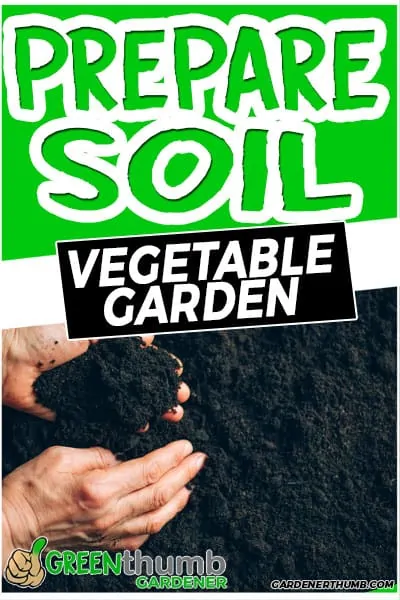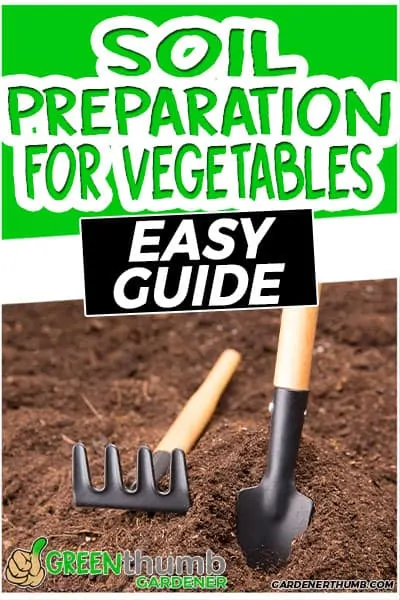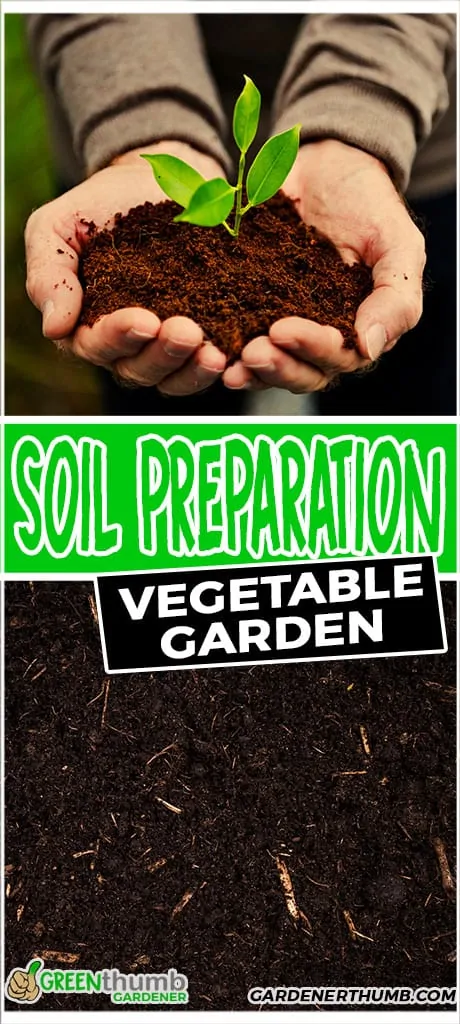How To Prepare Soil For Planting Vegetables [Black Gold]
Last updated: 10/1/20
I’ve always been concerned about making the right preparations before doing anything. So, I took that energy along when trying to plant veggies.
However, one area that I realized came with quite some stress was preparing my soil. I bet I’m not the only one wondering how to prepare soil for planting vegetables.
Well, that’s why I’ve put together this article. Here, I’ll tell you all you need to know.
Let’s dig in!
Green thumb Gardener occasionally links to product and/or services offered by vendors to assist you with all your gardening needs. Some of these may be affiliate links, meaning we earn a small commission if items are purchased.
Want to Download a Garden Hack Guide for FREE

Enter your email below and we will send you a guide to help you SAVE money in your garden.
Your Current Soil Health
Just before you get into planting, your soil health is one thing you need to pay attention to. And I bet you can tell why. Just like you, they only perform great when they are in good health.
So, here are the components of your soil health.
Nutrients
Well, your soil health depends on the availability of the various nutrients that it needs. Typically, your soil contains certain nutrients that your plants need to grow.
Now, where these nutrients are present, then your soil is in good health. Otherwise, you’ll need to do something about your soil.
Just so you know, the primary nutrients that make up your soil are potassium, nitrogen, and phosphorus. On the other hand, secondary nutrients include calcium, sulfur, and magnesium.
Other micronutrients such as copper, boron, zinc, manganese, cobalt, and iron perform specific and relevant functions.

pH Level
Also, beyond the soil nutrient, another aspect of soil health is the pH level. This refers to the acid-alkaline level of your soil.
It’s crucial as it’s critical to loads of soil functions, such as a plant’s capacity to absorb necessary nutrients. Usually, your soil needs to be between 6.0 to 7.0 for a good result. Although 6.5 is what’s ideal.
Testing Your Soil
Another important aspect of getting your soil ready for planting is testing it. The goal of this is to under use the current situation of your soil.
I bet it’s starting to seem all complicated. Well, don’t let it be. Here’s a step-by-step guide through which you can easily test your soil.
Step 1: Pick a Location
The first step is to pick the area where you plan to plant. And this is perhaps the easiest of what you’ll need to do.
However, one important thing here is to ensure that the area you pick gets enough sunlight. You’ll need somewhere that gets between 6 and 8 hours of sunlight each day. This is because your veggies need adequate sunlight to grow properly.
Then, once you do, stake the four corners of the area. This way, you don’t miss where you pick.
It would also be best to ensure the area is a minimum of 40 to 50 square feet. This way, there’s sufficient room for multiple vegetables.
Step 2: Loosen Your Soil
Now that you’ve picked an area, you’ll need to loosen the soil. And reaching a depth between 8 and 10 inches.
For you to do this, use a shovel or straight spade to dig the ground. Remember to go 8 to 10 inches into the soil.
Then, turn your soil over. The goal is to get the topsoil to the bottom. Do this throughout the area and ensure your soil has the same consistency and size.
However, remember to remove any sod or grass before you begin digging. And confirm there’s no electrical wire underneath the area.
You can always decide to use a mechanized cultivator or tiller to increase your speed.
Step 3: The Crumbling Test
Now, wear a glove and hold some soil with your hand. Afterward, squeeze the soil.
Here, you need to confirm if your soil forms a loose ball. And then crumbles immediately, after you squeeze hard. If it does, then you’re good to go as you’ve got a loamy soil.
However, if it doesn’t, and creates one hardball, then you’ve got clay soil. In this case, it’s an issue as it’s too thick to grow your plant properly.
If you’ve got a soil that doesn’t even make a ball, then it’s sandy. Once again, it’s not the best option for your plant.
Now, you can always do this in multiple locations to get the best-suited soil. Don’t worry; your soil structure isn’t always the same.
Step 4: Test the Soil’s Nutrients
You need to know the nutrient composition of your soil before you get into planting. And this is essential if you want to get the best results.
For you to do this, you’ll need to get soil samples, as much as ten scoops from different places in your area. Then, mix them properly until you’ve thoroughly combined them.
Afterward, apply the soil test kit with the guide provided. Don’t stress; you can always get a test kit from your local gardening stores. You can even order them online.
However, just for your ease, you’ll need to do the following when you get the kit.
- Place the soil in the container provided by the kit.
- Open up the capsules in each category.
- Pour water into the container and shake it until there’s a color change of the water.
- Then, match the color with the nutrients and pH facts of that color. You’ll find it on the test kit guide.
With this, you’ll get the pH level, nitrogen, potassium, and phosphorus level of your soil. Still, remember that you need a somewhat acidic soil between 5.8 to 6.5 acidic level.
Step 5: Test the Soil’s Drainage
For you to do this, you’ll need to put a hole in your soil. Ensure the hole is 12 inches deep and 12 inches in diameter.
Then, pour water inside using a hose. You’ll now need to let the water drain through the night. You can then fill it up again.
You should then measure the soil’s water level following an hour. Typically, proper draining should drain 2 inches every hour.
Remember that if your water drains too fast, your veggies won’t get adequate water. However, if it’s too slow, then your veggies will get waterlogged and might develop rot.
Knowing Your Current Soil Type
When I was telling you about testing your soil, one thing I mentioned was about your soil type. Yes, the crumbling test.
Well, one thing you need to know when preparing your soil is your soil type. And this is very important because it will determine the actions you need to take. Sometimes, even as to whether you need to improve your soil.
Well, there are three types of soil that you’ll come across in your planting journey. I’ll tell you about them right away.
Sandy Soil
This type of soil is one where sand is its major component. Usually, this soil type feels gritty when you touch them.
However, it’s not the best for planting. Typically, it’s usually nutrient deficient. This is because nutrients and moisture drain too fast from the soil. Then, there’s also a low amount of organic matter and beneficial microbes that the soil needs.
As such, it would be best not to use it for planting veggies. However, if that’s your only option, you can always improve it for planting. I’ll get to that later.
Clay Soil
This is one that has clay as its major constituent. Usually, they stack together and are flat.

Also, they are somewhat dense. They feel harsh when they are dry and sticky and slippery when they are wet.
However, they are also not the best for your veggies. This is because while they can hold moisture, it’s somewhat too much. As such, moisture doesn’t drain properly from it.
Even more, they tend to get hard when dry. In turn, this prevents air from getting to your plant roots. And you know this is bad news.
Due to their sticky nature, there’s hardly any microbial life or organic matter in it. As such, your plants will have quite a hard time germinating there.
Loamy Soil
This is your best bet for your veggies. This is because this soil combines all the beneficial properties of other types of soil.
It can retain nutrients and moisture effectively. Also, it usually has a higher pH and Calcium levels that ensure your veggies get all the nutrients they need.
4 Tips for Improving Your Existing Soil
One thing I’ve learned is that your soil isn’t always in the best condition. Even when you’re just starting up on a piece of land, there’s always a need for improvement.
So, you’ll need to improve your soil to ensure it meets up to your soil needs. Now, this isn’t as hard as others would have you believe.
Here are some tips that would help you.
Tilling
This is a great way to improve your soil’s quality. It involves breaking up your soil to include soil amendments. It’s also a great way to improve the current pH or nutrient imbalances of the soil.
However, remember not to overdo this as it will ruin your soil in the long run.
Also, don’t till wet soil. This is because it will cause trouble for your soil’s structure. So, wait for dry soil before tilling.
Double Digging
This is a smart way to improve your soil. And it’s particularly important where you want to improve your soil’s aeration and drainage.
For you to do this, here’s what you need to do.
First, remove a soil row and ensure it’s around 1 foot deep. However, ensure you keep the excavated soil. A tarp will do the trick.
Then, the hard layer below, loosen it using a spading fork.
Now, you’ll move to the next row and do the same trick. And keep doing this till you get to the end of the area.
However, always remember to deposit the topsoil you excavated to fill in the trench. The reserved soil will then be useful for the last trench.
Composting
Another great option is to enlist the help of organic materials. And this is particularly important if you’ve got clay or sandy soil.
You can do this with fallen leaves, manure, or composted yard waste. And like with most soil amendments, you’ll need to do this some weeks before planting begins. At least three weeks would be a great idea.
Now to do this, begin by applying a 2 inches compost on your soil. You can then mix them with a shovel. Then, in case you need more, another 2 inches will do the trick.
Fertilizers
You can always resort to fertilizers to improve your soil. They have variously mixed phosphorus, potassium, and nitrogen to help your veggies get the needed nutrients.
All you need to do is apply a 1-pound fertilizer to every 100 square feet area. You can then put it in the soil. This way, your soil absorbs the nutrients.
However, remember to avoid fertilizers if your soil already has adequate nutrients. Otherwise, you’ll only weaken your plants.
4 Tips to Get Started | Breaking New Ground
In no time, you’ll need to break new grounds with your veggies. However, this can sometimes turn out to be challenging.
I’ve been there, and I can tell you, there are various ways to make things easier for yourself. Well, here are some.
Raised Bed
You can always revert to a raised bed. And this is quite useful as it solves loads of your soil problems.
It’s quite simple. Rather than contend with your soil, you can get a raised bed. With it, you can then get the proper soil you need and pour it inside.
Yes, you’ll need to spend more. However, you can avoid the intense labor that you would have gone through.
Irrigation
As you must already know, your vegetables depend on water. And that’s where this comes in.
You can add an irrigation system that ensures your veggies get a steady supply of water. Even more, it allows you to reduce the risk of diseases associated with wet foliage.
Seedling
Your seeds are an important component of your planting. You use a bad seed, and you’re sure to record bad results.
So, ensure that your seeds are fresh and viable. Also, ensure that you abide by the planting depth requirement. This way, you avoid germination issues.
Weeding
You don’t want weeds on your soil when planting. Your best bet will be to ensure that you clear them away before you get to planting. And ensure you clear them in their early stage.
However, it’s not just about the surface. Instead, it’s about their root. So, ensure that you pull their roots from the soil.
Final Thoughts
Your soil is a major component of your planting journey. After all, it’s where you place your plants. Without it, there’s practically no way that veggie is coming to life.
Well, that’s why you need to prepare and care for it properly. I’ve run through all that you need to keep in mind.
So, get going, properly prepare your soil, and enjoy a bountiful yield this time.
Related Questions
What Is the Best Soil for Vegetables?
The most suitable soil for veggies has loads of organic matter and compost such as aged bark, composted leaves, or shredded leaves. The idea is to ensure that your soil isn’t compacted or sandy.
How Do You Prepare Bad Soil for Planting?
In case you’ve got a poor soil, you should try a raised bed that you can then fill with a well-adjusted soil mix. You can also add organic matter to improve your soil’s structure and move it from sandy-like to loam-like.









